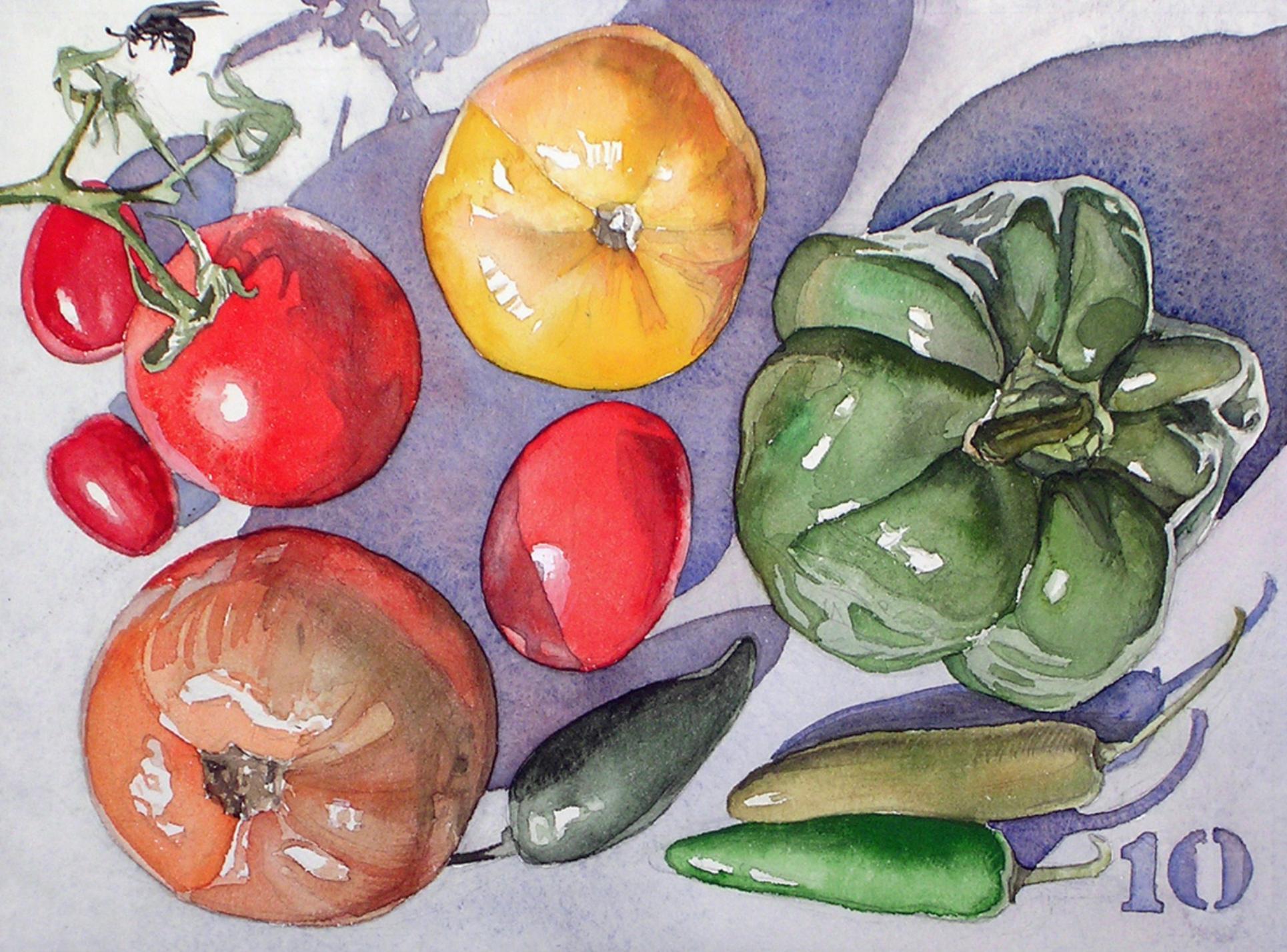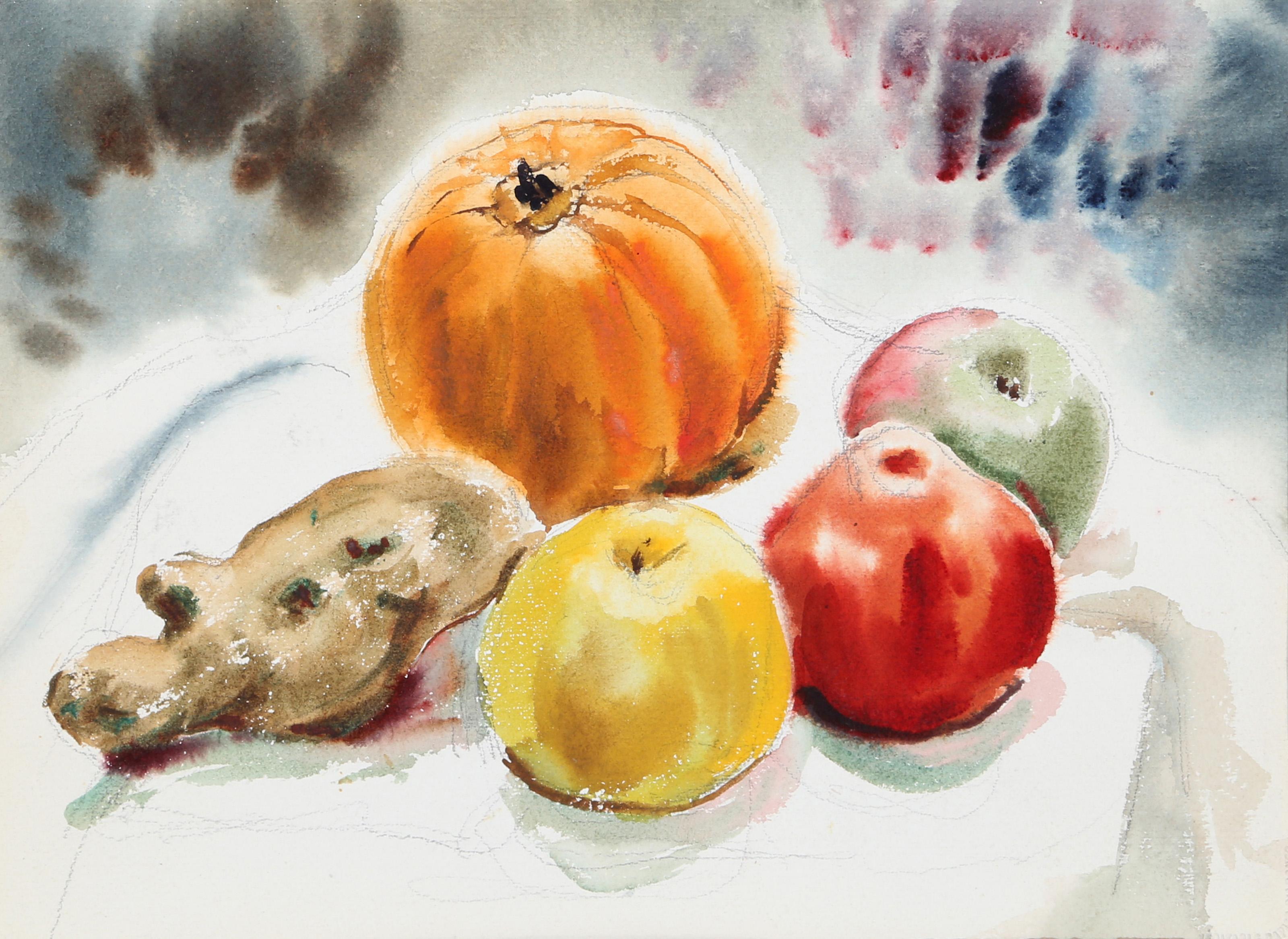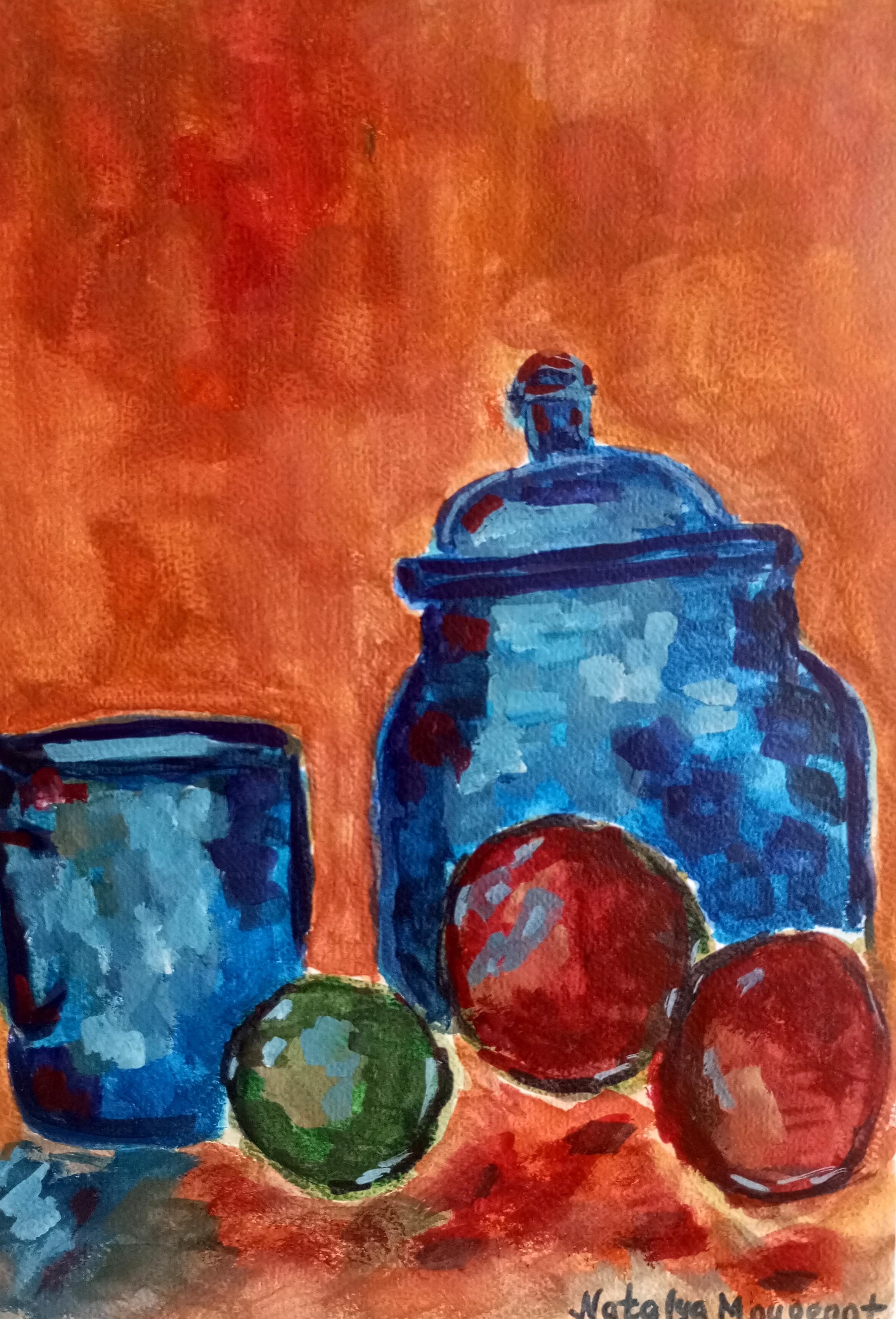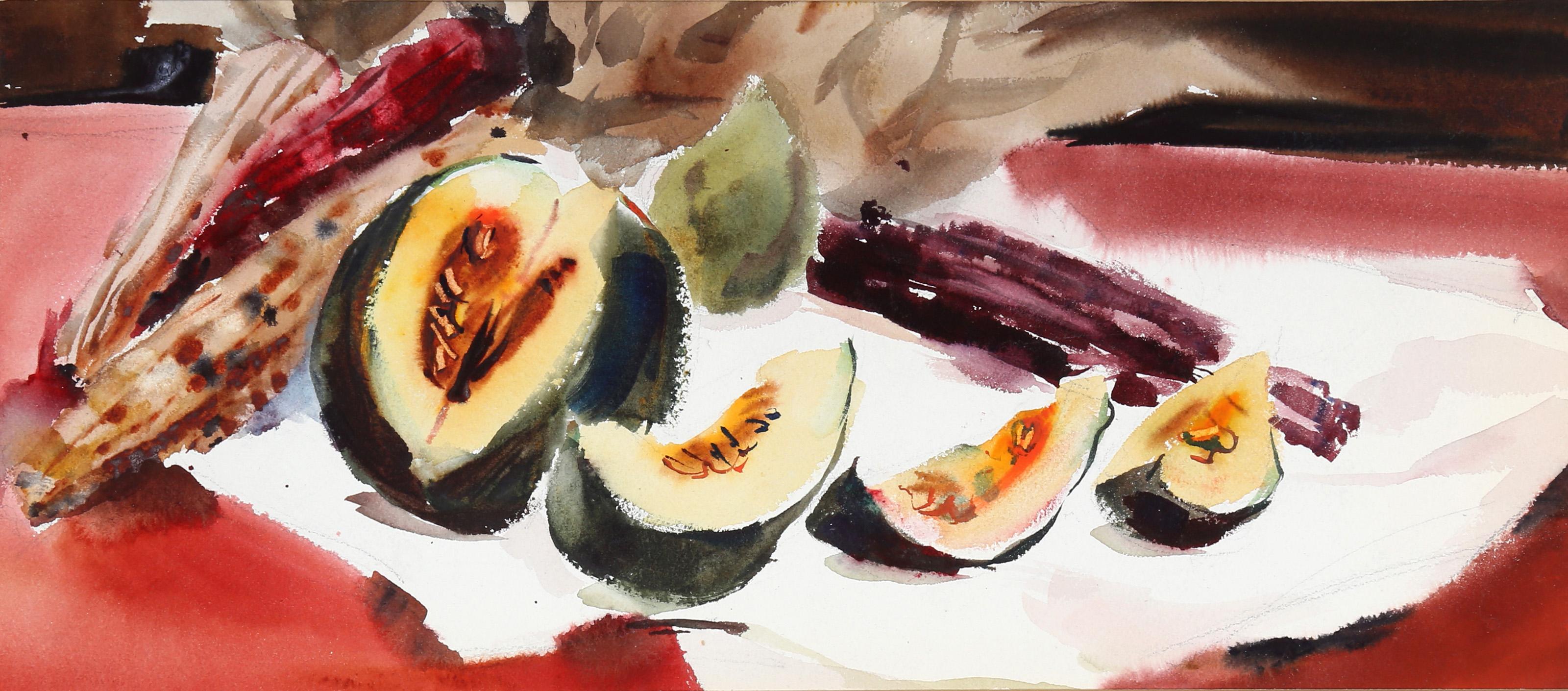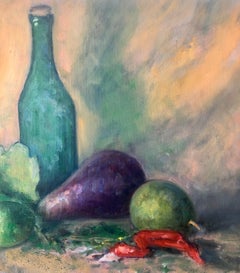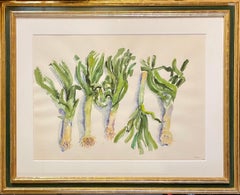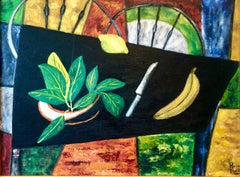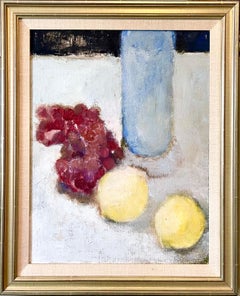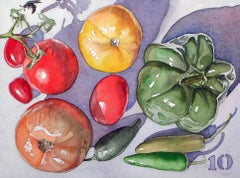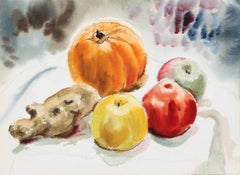Items Similar to Watercolor Still life Painting Vegetables Claus Hoien Greengrocer Kitchen Series
Want more images or videos?
Request additional images or videos from the seller
1 of 9
Claus HoieWatercolor Still life Painting Vegetables Claus Hoien Greengrocer Kitchen Series
$1,200
£910.53
€1,041.11
CA$1,676.07
A$1,863.57
CHF 973.05
MX$22,684.15
NOK 12,415.72
SEK 11,632.93
DKK 7,770.01
Shipping
Retrieving quote...The 1stDibs Promise:
Authenticity Guarantee,
Money-Back Guarantee,
24-Hour Cancellation
About the Item
Delicate watercolor of vegetables. Japanese eggplant and radishes and a squash gourd.
Framed 18 X 20 image is 11 X 13.5
Claus Hoie was a Norwegian-American Postwar & Contemporary artist who was born in 1911. His work was featured in exhibitions at the Long Island Museum and the Guild Hall Museum.
Claus Hoie was born in Stavanger, Norway, November 3, 1911. He lived for a few years in Oslo before emigrating to the United States at the age of thirteen, when he settled in Brooklyn, NY. He studied art at the Pratt Institute and at the Art Students League in New York. He spent time at sea (two Years), a heritage from his grandfather and father who were both ship’s captains. During World War II, Hoie served four years in the Army as a sergeant in a special Norwegian-American battalion of the mountain infantry (99th Infantry Battalion), whose mission was to assist in the liberation of Norway. His Battalion also landed on Normandy Beach five days after D-Day. After the war, he studied art at the Ecole des Beaux Arts in Paris. His wife, Helen, is also an artist.
Hoie worked as an independent artist creating mostly watercolors and graphics but also was a commercial artist. He has exhibited his watercolors and graphics at the American Watercolor Society between 1960 and 1994; Brooklyn Museum Watercolor Biennial, 1963; Museum of Watercolor Painting, Mexico City, Mexico, 1968 and 1989; Pennsylvania Academy of Fine Arts Annual, 1969; and the Childe Hassam Award Exhibition, National Institute of Arts and Letters, 1973. He has had numerous one-man shows in places such as the Norwegian-American Museum, Decorah, IA, 1976; Akershus Castle Museum in Oslo, Norway, 1982; South Street Seaport Museum, NY, 1992, Mystic Seaport Museum, 1994 and 1998; and, the Nordic Heritage Museum, Seattle, 1998. Hoie has also been the author of several articles about his work. He has written and illustrated a book, Whaler Helena of Sag Harbor in the South Pacific, 1843-1845 (1994). In addition, he provided some text and illustrations for a booklet entitled, "The Viking Battalion" by Audrey Wendland published in 1998.
He received numerous awards for his work including prizes awarded in 1985 and 1988 from the National Academy of Design, honors and medals from the American Watercolor Society spanning the years 1955 through 1988, an award from the American Academy and Institute of Arts and Letters in 1975, and an award from the Audubon Artists Annual Exhibition in 1990. He also received the Marine Environmental Wildlife Award from the Mystic Seaport Museum in 1998.
Hoie’s paintings and graphics are in the collections of the Brooklyn Museum, Oklahoma Museum of Art, National Academy of Design, Norwegian-American Museum, University of Minnesota, and Brigham Young University. The works he exhibited at the Norwegian-American Museum eventually were acquired by Akershus Museum in Oslo, Norway. These watercolors focused on the training of mountain troops for the U.S. Army Special Forces unit of which he was a member during World War II. Hoie’s seafaring family origins inspired a long lifetime of painting sailing vessels, fish, whalers, and Moby-Dick, among other subjects. The idea of a “fantasia” (a mixture of forms and styles) fits the varied styles of Claus Hoie (1911-2007), who sometimes incorporated a variety of elements such as text from logbooks into his artworks.
Select Exhibitions
2013 Clinton Academy Museum; East Hampton, New York (solo)
2012–2013 Bridgehampton Museum; Bridgehampton, New York (solo)
2011 East Hampton Marine Museum; Amagansett, New York (solo)
2011 Nantucket Whaling Museum; Nantucket, Massachusetts (solo)
1967–2007 National Academy of Design Annuals; New York, New York
2004–2005 RETROSPECTIVE; Guild Hall Museum, East Hampton, New York (solo)
2002 Mystic Seaport Museum International; Mystic, Connecticut
1998 Nordic Heritage Museum; Seattle, Washington (solo)
1984–1997 Vered Gallery, East Hampton, New York (solo)
1992 South Street Seaport Museum; New York, New York (solo)
1991 Parrish Museum; Southampton, New York
1989 Mexico Museum of Watercolor; Mexico City
1984 Bernice Steinbaum Gallery; New York, New York “1+1=2”
1982 Guild Hall Museum; “Poets & Artists” East Hampton, New York
1980 Alex Rosenberg Gallery; New York, New York “Printmakers”
1980 American Academy and Institute of Arts and Letters; Watercolor USA Annuals, New York,
1978–1980 Smithsonian Traveling Exhibition “Artist’s Postcards”
1965 Royal Academy of London
1964 Brooklyn Museum Watercolor Biennial, Brooklyn, New York
Select Public Collections
Mystic Seaport Museum, Connecticut
Nantucket Whaling Museum, Massachusetts
National Academy of Design, New York
Nordic Heritage Museum, Seattle, Washington
Norfolk Museum, Virginia
Norwegian American Museum, Iowa
South Street Seaport Museum, New York
Akershus Museum, Oslo, Norway
Bridgehampton Museum, Bridgehampton, New York
Brigham Young University, Utah
Brooklyn Museum, New York
Butler Institute, Ohio
Clinton Academy Museum, East Hampton, New York
Cold Spring Harbor Whaling Museum, New York
East Hampton Marine Museum, Amagansett, New York
Guild Hall Museum, East Hampton, New York
Long Island Museum of American Art, Stony Brook
- Creator:Claus Hoie (1911 - 2007, Norwegian, American)
- Dimensions:Height: 18 in (45.72 cm)Width: 20 in (50.8 cm)
- Medium:
- Movement & Style:
- Period:
- Condition:good. needs new mat frame has minor wear. please see photos.
- Gallery Location:Surfside, FL
- Reference Number:1stDibs: LU38215876012
About the Seller
4.9
Platinum Seller
Premium sellers with a 4.7+ rating and 24-hour response times
Established in 1995
1stDibs seller since 2014
1,784 sales on 1stDibs
Typical response time: <1 hour
- ShippingRetrieving quote...Shipping from: Surfside, FL
- Return Policy
Authenticity Guarantee
In the unlikely event there’s an issue with an item’s authenticity, contact us within 1 year for a full refund. DetailsMoney-Back Guarantee
If your item is not as described, is damaged in transit, or does not arrive, contact us within 7 days for a full refund. Details24-Hour Cancellation
You have a 24-hour grace period in which to reconsider your purchase, with no questions asked.Vetted Professional Sellers
Our world-class sellers must adhere to strict standards for service and quality, maintaining the integrity of our listings.Price-Match Guarantee
If you find that a seller listed the same item for a lower price elsewhere, we’ll match it.Trusted Global Delivery
Our best-in-class carrier network provides specialized shipping options worldwide, including custom delivery.More From This Seller
View AllAmerican Impressionist Fruits, Vegetables and Bottle Oil Painting
By William Schultz
Located in Surfside, FL
William J. Schultz, American (1919 - 2005)
William J. "Bill" Schultz had been a renowned American Impressionist artist and teacher for over sixty-five years.
Co-Founder, and Director of the AIS had inspired numerous professional artists and teachers through his teaching. He also was a Master Pastelist in the Pastel Society of America and had won many awards for his oil and pastel paintings.
Born in Pittsfield, Massachusetts in 1919, he died in Vero Beach, Florida in 2005. He served in the Army in World War II including duty in Europe. He was discharged in 1946 with rank of First Sergeant. Schultz began his art studies with Martin C. Hoy, a fine artist and student of Robert Henri and William M. Chase. He graduated from The Vesper George School Of Art in Boston, Massachusetts in 1949. He then studied under National Academicians Jerry Farnsworth, Ivan Olinsky (a student of John Singer Sargent) and Robert Brackman. Winner of many awards for oil and pastel works. Was a noted portrait artist.
He was a founding Director of the American Impressionist Society and an award winning member of the Pastel Society Of America. He studied under notable National Academicians Robert Brachman, Ivan Olinsky and Jerry Farnsworth.
Schultz opened his own art studio and school in Lenox, Massachusetts and taught impressionist painting to hundreds of students, some of whom are now nationally recognized themselves. After 25 years at that location Schultz and his wife moved to Vero Beach, Florida where he continued to teach, as well as provide lectures and exhibitions around the country.
Illustrated articles about Schultz and his work have appeared in "American Artist", "Southwest Profiles", "Artists Of Florida" and other periodicals.
For a short time he studied alongside Norman Rockwell at a studio in Stockbridge, Massachusetts where Rockwell had established the base for his illustration work. Schultz was the proud possessor of an autographed sketch of himself that Norman Rockwell had created and was signed by Rockwell.
Schultz's art has been exhibited in museums and galleries in Boston, New York City, Sante Fe, and numerous Florida locations...
Category
20th Century American Impressionist Interior Paintings
Materials
Canvas, Oil
Large American Modernist Watercolor Painting Leeks Bernard Chaet Expressionist
By Bernard Chaet
Located in Surfside, FL
Hand signed and dated leeks on a kitchen table
31.5 X 39.5 framed. 21 X 28.5 sheet without frame.
Bernard Chaet (born 1924, Boston, MA - 2012) was an American artist; Chaet is known for his colorful, dynamic modernist paintings and masterful draftsmanship, his association with the Boston Expressionists, and his 40-year career as a Professor of Painting at Yale University. His works also include watercolors and prints. In 1994, he was named a National Academician by the National Academy of Design. Chaet was instrumental in transforming Yale’s traditional art program into one with a more modernist approach that gained national prominence.
Chaet melded landscape and abstraction in a traditional established by Vincent Van Gogh, Georges Seurat, Edvard Munch, Piet Mondrian, and Ferdinand Hodler. His own tenure began in 1951 at Yale, where he worked closely with Josef Albers to revamp Yale’s art program. Between 1959 and 1962 he was the chair of what was then called the Yale Department of Art of the School of Fine Arts — prior to becoming one of the independent professional schools at Yale in 1973. Chaet taught painting and drawing and mentored generations of emerging talents. Chaet was the author of the 1970 textbook “The Art of Drawing” and “An Artist’s Notebook 1979,” both of which have since been reissued several times. In the latter book, alongside examples of work by his favorite artists, are student drawings by Yale graduates such as Robert Birmelin, Michael Mazur and Eugene Baguskas.
Born in Boston, Massachusetts, in 1924, Chaet studied at the School of the Museum of Fine Arts in Boston and then earned a B.A. at Tufts University. Known for his expressionist landscapes and still lifes, Chaet’s work has continuously been shown in galleries in his native Boston, in New York City, and around the country. In 2010, a retrospective of his seascapes was featured at the Cape Ann Historical Society in Gloucester, Massachusetts, where he had a home and a summer studio in nearby Rockport. His has also exhibited at David Findlay Gallery in New York and at Swarthmore College. Many of Chaet’s students went on to notable art careers, including Janet Fish, Chuck Close, and Richard Serra. His work is represented in the collections of the Brooklyn Museum, the Art Institute of Chicago, the Metropolitan Museum of Art in New York, the DeCordova Sculpture Park and Museum in Lincoln, Massachusetts, the Hirshhorn Museum and Sculpture Garden in Washington, D.C., the Museum of Fine Arts in Boston, the Yale University Art Gallery in New Haven, CT, and the Addison Gallery of American Art in Andover, MA.
Chaet is the recipient of many awards including: the National Foundation of the Arts and Humanities, Sabbatical Grant in 1967-68, the National Academy of Fine Arts, Benjamin Altman Award in Painting in 1997, and the American Academy of Arts and Letters Jimmy Ernst Prize in 2001. Chaet was born and raised in the Dorchester neighborhood of Boston, MA. He completed a dual program at the Museum of Fine Arts, Boston—studying painting with Karl Zerbe—and Tufts University, graduating with a B.S. in 1949. Chaet is known for his association as a first generation Boston Expressionist. (along with Hyman Bloom and Jack Levine)
Chaet was a contributing editor to Arts Magazine. In 1960 he published the book Artists At Work, which features in depths conversations with artists Pat Adams, Anni Albers, Josef Albers, Al Blaustein, Hyman Bloom, James Brooks, Robert Engman...
Category
1970s American Modern Still-life Paintings
Materials
Watercolor, Gouache, Archival Paper
Colorado Woman Abstract Expressionist Oil Painting Modernist Still Life, Fruit
By Ruth Todd
Located in Surfside, FL
Ruth Todd (1909-2006, American Woman Artist) one of Colorado’s most prominent avant-garde artists and played a significant role in Colorado’s art history. Known for painting and collage.
Still life with lemon and banana on kitchen table.
Ruth Thomas Todd was born in 1909 in Sanford, North Carolina. She arrived in New York City in the 1930s where she began her career as a fashion model supporting herself as she attended classes at the Art Students League. For reasons of health she moved to Colorado Springs to treat her condition. During her recuperation she started to draw and studied under famous American abstract painter Robert Motherwell, who was teaching at the Colorado Springs Fine Arts Center at the time. By the 1950s, her career as an abstract expressionist painter was blooming. She was one of Colorado’s most visible and avant-garde artists. Ruth married Littleton Todd, a poet and a woodworker. In 1953, Todd traveled to Europe (Paris, France) to study art and to paint. Littleton Todd opened a design studio in Denver where he manufactured and sold modern furniture. She would incorporate sawdust and other found materials from the workshop imbued with oil paint into her abstract work to create unique topographies and patterns. She showed at numerous Gilpin County Art Exhibitions, the Denver Art Museum, the Colorado Springs Fine Arts Center, Colorado Women’s College, the University of Colorado, Boulder, the Colorado State Fair, and the Jewish Community Center. Among the Colorado Modernists that she exhibited with were Vance Kirkland, Frank Vavra, Martha Epp, Ardis Sturdy...
Category
1950s Modern Still-life Paintings
Materials
Oil, Board
Fruit Still Life Oil Painting Betsy Podlach American Post Feminist Modernist Art
By Betsy Podlach
Located in Surfside, FL
Betsy Podlach (American, born 1964.)
Still life with Fruit and Glass Bottle
Framed it measures 26.5 X 21.5 Canvas is 21.5 X 16.5
Betsy Podlach graduated from Harvard, cum laude, (she studied at Harvard with Alfred Decreido and William Reimann as well as Carlos Fuentes continuing her studies at the New York Studio School of Drawing, Painting, and Sculpture, Ms. Podlach was awarded an art fellowship and residency at The International School of Art in Umbria, Italy.
Betsy Podlach is an American painter who considers the Italian Venetians and the american abstract expressionist painters her mentors. The two painters she is most inspired by are Titian and Jackson Pollock, Both use the picture plane and abstraction and space, light, movement and form to communicate a physicality built entirely on the principals of painting, in the “classical” sense of a flat plane and lines, color, shape, space and light applied to that flat surface to create magic – light, space, form, emotion, force, movement, the physical and the spiritual. She describes her work as a figurative version of abstract expressionism. She was influenced by many of the abstract expressionists from the NY school...
Category
1990s American Impressionist Figurative Paintings
Materials
Canvas, Oil
"Shrine I" Watercolor with Lacquer Mixed Media
By Yuriko Takata
Located in Surfside, FL
Yuriko Takata's work is a simple celebration of the beauty of nature. Her floral prints range from delicately rendered watercolors reminiscent of French antique botanical prints to bold, pastel still-life images inspired by the oil paintings of the old Dutch Masters. After making extensive sketches in exotic and beautiful locations around the world, Takata returns to the privacy of her own studio to complete her works. She eagerly explores different artistic styles, and her talent lies in her ability to foresee interior design developments and focus her imagery on these trendsetting styles. Always searching for new insights and visual experiences, Takata's interests range from realistic still-life and landscape to the exploration of purely abstract imagery with a simplified surface. Takata was born and raised in California but still converses in Japanese with her mother, who studies the ancient Japanese art of flower arranging. Although she frequently visits the rest of her family in Japan, Takata considers the San Francisco Bay area her home. With exhibits in the United States, Europe and Japan, Takata's work is held in the collections of AT&T, Bank of America, Dean Witter, Foremost McKesson, Hollister, Inc., Illinois Bell...
Category
Late 20th Century Modern Mixed Media
Materials
Wood, Mixed Media, Watercolor
Still Life Tabletop with Fruit
By George Chemeche
Located in Surfside, FL
This is a bright, colorful oil painting of a table top with fruit. Banana, Pomegranate and glass of water.
George Chemeche was born in Israel in 1934 and studied at the Avni Art School in Tel Aviv and the Ecole des Beaux Arts in Paris. this painter and printmaker's sensual and romantic yet rationally conceived screen prints featuring plants and flowers are associated with the PATTERN & DECORATION movement of the late 1960s and early 1970s.
His style is non-minimalist, sensuous, romantic, rational and decorative. it runs counter to the modernist taboo against a decorative quality in art. Though pattern painting's roots are in modern art, it contradicts some of its basic tenets as it attempts to assimilate aspects of Western and non-Western culture not previously accepted into the realm of high art. In Chemeche´s work, we can see how chosen motifs are repeated in order to cover a surface in a uniform way. The results often have a painterly feel, but remain systematic. The intention is to make a high-art statement within a contemporary context by referring to, and using what to many still remains within the world of non-art. Pattern painting, unlike abstractionism, has structure. It also has content as it refers to patterns in the real world. Usually, patterning intentionally acknowledges the decorative function of art, reconciling both the decorative and the meaningful.
INDIVIDUAL EXHIBITIONS:
Goldman Art Gallery, Haifa, Israel
Gordon Gallery, Tel Aviv, "Six Artists"
Biv Gallery, New York, "Chelsea Artists"
Makler Gallery, Philadelphia, Pa.
"FJ.A.C.," Petit Palais Paris Galerie Naire, Paris
Weintraub Gallery, New York, Print Show
Louis K. Meisel Gallery, New York
Alexandra Monett Gallery, Brussels
Givon Art GaJIery, Tel Aviv
South Houston Gallery, New York
Ray Landis Gallery, East Brunswick, New Jersey
Gala Gallery, Key Biscayne, Florida
Art Asia Gallery, Cambridge, Mass.
Bertha Urdang Gallery, New York
Selected Artists Gallery, New York
Mabat Art Gallery, Tel Aviv
Goldman Art Gallery, Haifa, Israel
OHana Gallery, London
"Six Artists", Modern Art Gallery, Old Jaffa
Modern Art Gallery, Old Jaffa
The Autumn Exhibition, Tel Aviv Museum
Dugith Art Gallery, Tel Aviv
Hadassa "K" Klachkin Art Gallery, Tel Aviv
Rina Art Gallery, Jerusalem The Museum of Modern Art, Haifa
Chemerinsky Art Gallery, Tel Aviv
Galerie Transposition, Paris Collective Exhibitions
"Young Artists", Tel Aviv Museum
Salon de La Jeune Peinture, Musee d'art Moderne, Paris
A well listed Painter...
Category
1960s Expressionist Still-life Paintings
Materials
Oil
You May Also Like
Vegetable Still Life No. 10 Contemporary watercolor by Ohio trompe l'oeil artist
Located in Beachwood, OH
George Mauersberger (American, 20th Century)
Veg 10, 2004
Watercolor on paper
9 x 12 inches
13 x 16 inches, framed
George Mauersberger completed t...
Category
Early 2000s Photorealist Still-life Drawings and Watercolors
Materials
Watercolor
Fruit Still Life, Impressionist Watercolor by Eve Nethercott
By Eve Nethercott
Located in Long Island City, NY
Eve Nethercott, American (1925 - 2015) - Fruit Still Life (P5.19), Year: 1960, Medium: Watercolor on Paper, Size: 10.5 x 14 in. (26.67 x 35.56 cm), Description: Arranged arou...
Category
1960s Impressionist Still-life Drawings and Watercolors
Materials
Watercolor
Vegetable Still Life No. 7, Contemporary watercolor by Ohio trompe l'oeil artist
Located in Beachwood, OH
George Mauersberger (American, 20th Century)
Veg 7, 2004
Watercolor on paper
9 x 12 inches
13 x 16 inches, framed
George Mauersberger completed th...
Category
Early 2000s Photorealist Still-life Drawings and Watercolors
Materials
Watercolor
Vegetable Still Life No. 2, Contemporary watercolor by Ohio trompe l'oeil artist
Located in Beachwood, OH
George Mauersberger (American, 20th Century)
Veg 2, 2004
Watercolor on paper
9 x 12 inches
13 x 16 inches, framed
George Mauersberger completed th...
Category
Early 2000s Photorealist Still-life Drawings and Watercolors
Materials
Watercolor
Contemporary impressionist still-life fruits watercolor painting on paper
Located in VÉNISSIEUX, FR
This still life painting "One green apple and two red apples" features a blue jar with lid, a blue cup, two red apples, and a green apple on an orange-red surface.
This piece eman...
Category
2010s Contemporary Still-life Paintings
Materials
Paper, Watercolor
$297 Sale Price
20% Off
Free Shipping
Fruit Still Life, Impressionist Watercolor by Eve Nethercott
By Eve Nethercott
Located in Long Island City, NY
Eve Nethercott, American (1925 - 2015) - Fruit Still Life (P3.14), Year: 1959, Medium: Watercolor on Paper, Size: 9 x 20 in. (22.86 x 50.8 cm), Description: Set before a pile...
Category
1950s Impressionist Still-life Drawings and Watercolors
Materials
Watercolor
More Ways To Browse
Sea Life Paintings
Paintings Of Kitchens
Mexican Still Life
Guild Hall
Vegetable Painting
Marine Watercolours
Watercolor Marine Art
Hampton Vintage Painting
Vegetable Still Life
Helen Manning
South Pacific Painting
Vintage Captain America
Helen Young
Sea Captain Painting
Wildlife Watercolor
Utah Mountains
Marine Sailing Ships
Watercolor Utah
